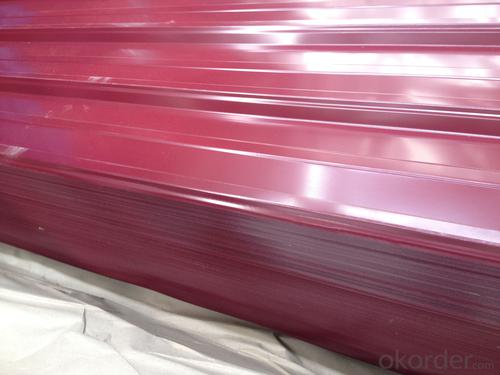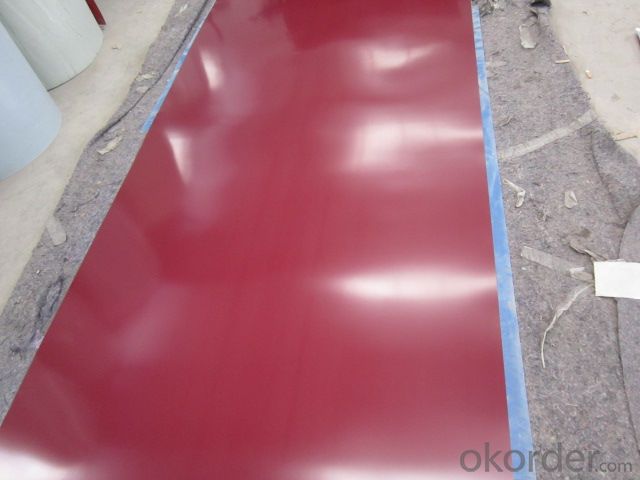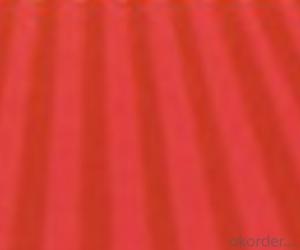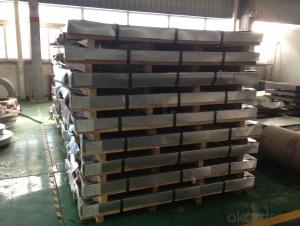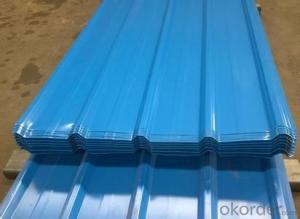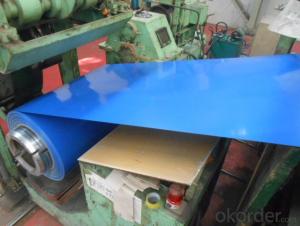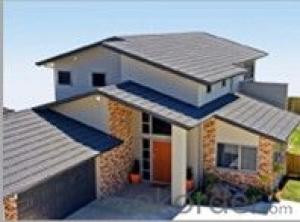Corrugated Pre-painted Galvanized Steel Sheet
- Loading Port:
- Tianjin
- Payment Terms:
- TT OR LC
- Min Order Qty:
- 25 m.t.
- Supply Capability:
- 1000 m.t./month
OKorder Service Pledge
OKorder Financial Service
You Might Also Like
Corrugated Pre-painted Galvanized Steel Sheet
Description:
Corrugated Pre Painted Steel Coil is coated with organic layer, which provides higher anti-corrosion property and a longer lifespan than that of galvanized steel sheets.
The base metals for Pre Painted Steel Coil consist of cold rolled, HDG electro-galvanized and hot-dip alu-zinc coated steel. The finish coats of Pre Painted Steel Coil can be classified into groups as follows: polyester, silicon modified polyesters, polyvinylidene fluoride, high-durability polyester, etc.
Pressing steel panel can be freely incised, it can satisfy the especially designing demands. It apply on convenient construction, and anti-seismic performance, fire proof, waterproof, free of maintenance, ect.
Base sheet : galvanized steel sheet, pre painted galvanized steel sheet
Application:
Since it adopts high strength steel sheet and the dimension is designed reasonably, the corrugated sheets are widely used on roofs and walls of various buildings, which can be easily installed, be flexible and changeable, unrestricted by no factor of the buildings.
Corrugated steel sheet is the colored steel plate which has been wave formed with the cold rolling treatment, trough especial coated dispose, the color coated steel panel’s guaranty is 12-15 years.
It has been widely applied on civil construction like storerooms, special building roof and walls of wide-span steel structure building and so on.
Product Specification:
Paint: PE or PVDF
Width and Thickness: width within 1250mm, thickness from 0.23-0.8
Color pre painted steel in coil
Zinc Coating: 50-180g/m2
Top coating:5 mic epoxy+20 mic pe, protection film
Back coating: 7 mic epoxy grey
Weight per coil:3-5 tons
Standard:JIS G3312,CGCC
Package:Standard seaworthy export packing: 3 layers of packing, inside is kraft paper,water plastic film is in the middle and outside GI steel ,sheet to be covered by steel strips with lock.
FAQ:
1.How many pieces for one package and the weight for one package?
The pieces for one tone is decided by the thickness of the sheet, but we can make it according to your requirements in the reasonable range.
Usually 2-3 tons for one package.
2. Could you provide special coulor for the sheet?
Yes, we can produce the goods according to the customer’s requirements.
3. Can you design the label according to our requirements?
Yes, we can. You just need to provide us the picture.
- Q: Can steel sheets be used for fencing and gates?
- Yes, steel sheets can be used for fencing and gates. Steel sheets are a durable and strong material that can provide security and protection when used for fencing or gates. They can be customized to various sizes and designs, making them suitable for different fencing and gating needs.
- Q: What is the typical thickness for steel sheets used in construction?
- The typical thickness for steel sheets used in construction can vary depending on the specific application and requirements. However, commonly used thicknesses range from 1.6 mm (1/16 inch) to about 25 mm (1 inch). Thinner steel sheets are often used for interior and non-structural applications, such as wall panels or decorative features. On the other hand, thicker steel sheets are commonly utilized in structural components like beams, columns, and support systems. It is important to note that the thickness of steel sheets can be customized and adjusted according to the specific needs of a construction project.
- Q: Are steel sheets suitable for interior partition walls?
- Yes, steel sheets are suitable for interior partition walls. They are durable, fire-resistant, and provide exceptional strength and stability. Additionally, steel sheets can be easily customized and offer a sleek and modern aesthetic for interior spaces.
- Q: Can steel sheets be used for manufacturing automotive parts?
- Yes, steel sheets can be used for manufacturing automotive parts. Steel sheets are widely used in the automotive industry due to their strength, durability, and cost-effectiveness. They can be easily formed, welded, and shaped into various automotive components such as body panels, chassis parts, and structural elements.
- Q: Can steel sheets be used for industrial machinery?
- Absolutely, industrial machinery can certainly make use of steel sheets. Steel is a highly popular material within the manufacturing sector because of its remarkable strength, durability, and adaptability. By shaping, machining, and welding steel sheets, one can create a wide range of sizes and forms that cater to the precise needs of industrial machinery. Moreover, steel sheets possess outstanding resistance against corrosion, impact, and extreme temperatures, rendering them perfect for demanding applications. Employing steel sheets in industrial machinery guarantees structural integrity, long lifespan, and improved functionality, thus establishing itself as the preferred option for countless manufacturers in the field.
- Q: What is the electrical resistivity of steel sheets?
- The electrical resistivity of steel sheets typically ranges from 10 to 20 micro-ohm meters.
- Q: Can the steel sheets be used for kitchen countertops?
- Kitchen countertops can indeed be made from steel sheets. Steel proves itself as a durable and enduring material, capable of withstanding high temperatures, rendering it fitting for kitchen purposes. Moreover, it is resistant to stains, scratches, and water damage, simplifying cleaning and maintenance. Furthermore, steel countertops can lend a sophisticated and contemporary appearance to any kitchen. Nevertheless, it is essential to be mindful that steel is susceptible to scratches and dents, necessitating caution when handling sharp utensils or heavy objects on the countertop.
- Q: What is the typical impact resistance of a steel sheet?
- The typical impact resistance of a steel sheet can vary depending on various factors such as the type and grade of steel, thickness of the sheet, and the specific conditions of impact. However, steel sheets are generally known for their high impact resistance due to the material's strength and durability.
- Q: How do steel sheets perform in terms of air permeability?
- Steel sheets are not permeable to air, meaning they do not allow air to pass through them easily.
- Q: How do you join two steel sheets together?
- One common method to join two steel sheets together is through welding. This involves melting the edges of the steel sheets and fusing them together using a welding electrode or wire. Another option is using bolts, screws, or rivets to mechanically fasten the two sheets together. Adhesive bonding is also a possibility, where a strong adhesive is applied between the sheets to create a secure bond. Ultimately, the choice of joining method depends on factors such as the specific application, desired strength, and cost considerations.
Send your message to us
Corrugated Pre-painted Galvanized Steel Sheet
- Loading Port:
- Tianjin
- Payment Terms:
- TT OR LC
- Min Order Qty:
- 25 m.t.
- Supply Capability:
- 1000 m.t./month
OKorder Service Pledge
OKorder Financial Service
Similar products
Hot products
Hot Searches
Related keywords



